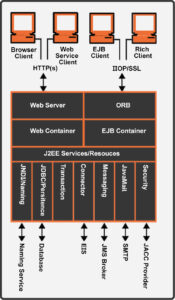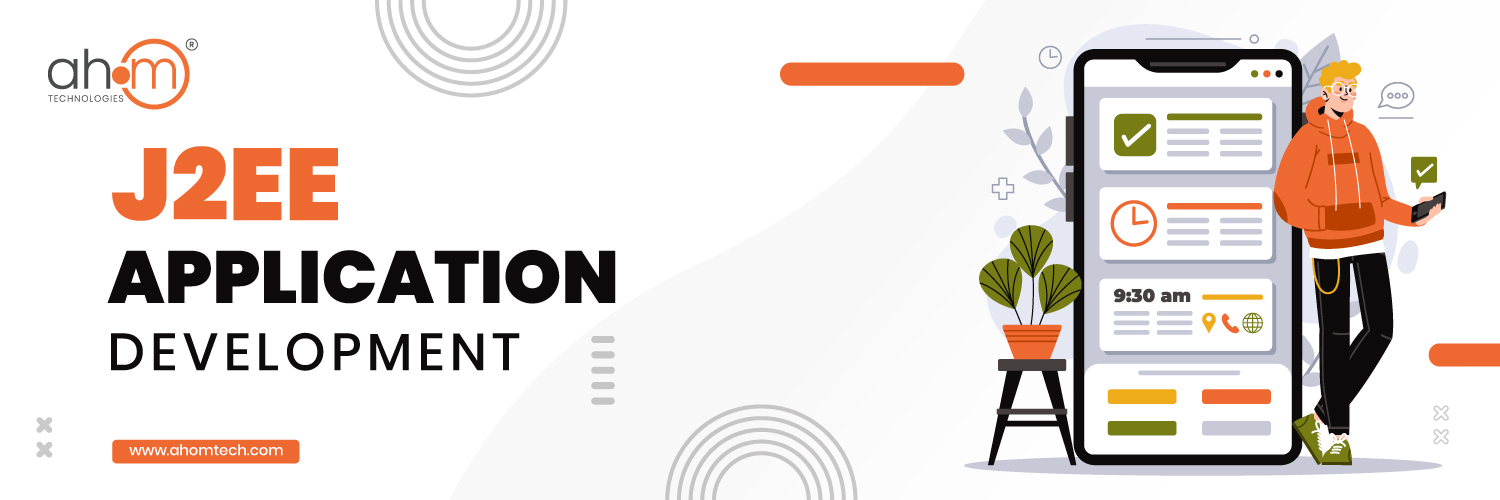Application servers implement Java 2 Enterprise Edition (J2EE Application development) technology 1.4, which sets the standard for developing multi-tier enterprise applications.
Demonstration of J2EE Platform
The J2EE platform simplifies enterprise applications by relying on standardized and modular components, providing a comprehensive set of services for these components, and managing many of the details of application behavior used automatically without complicated programming.
J2EE Application
J2EE applications are made up of components like JavaServer Pages (JSP), Java servlets, and Enterprise JavaBeans (EJB) modules.
These components enable software developers to build large-scale distributed applications. Developers package J2EE applications into Java Archive (JAR) files (similar to zip files),
Which can be distributed to production sites. An administrator installs a J2EE application on an application server by deploying a J2EE JAR file to one or more server instances (or clusters of instances).

Components of the J2EE Platform
The following figure illustrates the components of the J2EE platform discussed in the following sections.
Containers
The J2EE application model divides enterprise applications into three fundamental parts: components, containers, and connectors.
Application developers are focused on components, whereas system suppliers use containers and connectors to hide complexity and encourage portability.
The container works as a bridge between the client and the components, transparently providing transaction support and resource aggregation to both. Multiple component behaviors can be set at implementation time rather than in program code with container mediation.
Each server instance in Application Server has two containers: Web and EJB. A container is a runtime environment for J2EE components that provides security and transaction management.
The web container is where web components like Java Server Pages and Servlets run. EJB containers hold Enterprise JavaBeans.
J2EE Service
J2EE platform services simplify application programming and allow components and applications to be customized at deployment time to use resources available in the deployment environment.
This section provides a brief overview of the J2EE platform’s naming, deployment, transaction, and security services.
The J2EE platform provides services to applications, including:
- Naming -A naming and directory service binds objects to names. A J2EE application can locate an object by looking up its Java Naming and Directory Interface (JNDI) name.
- Security – The Java Authorization Contract for Containers (JACC) is a set of security contracts defined for the J2EE containers. Based on the client’s identity, containers can restrict access to the container’s resources and services.
- Transaction management – A transaction is an indivisible unit of work. For example, transferring funds between bank accounts is a transaction. A transaction management service ensures that a transaction is either completed, or is rolled back.
- Message Service – Applications hosted on separate systems can communicate with each other by exchanging messages using the Java™ Message Service (JMS). JMS is an integral part of the J2EE platform and simplifies the task of integrating heterogeneous enterprise applications.
Web Services
Clients can access a J2EE 1.4 application as a remote web service in addition to accessing it through HTTP, RMI/IIOP, and JMS.
Web services are implemented using the Java API for XML-based RPC (JAX-RPC). A J2EE application can also act as a client to web services, which would be typical in network applications.
WSDL is an XML format for describing web service interfaces. Consumers of web services can dynamically read a WSDL document to discover the activities a web service offers and how to execute them.
The Application Server uses a registry to publish web service interface descriptions, which other programmes can access via the Java API for XML Registries (JAXR).
Client’s Access Rights
Customers can access J2EE applications in a number of ways. Browser clients access web applications using Hypertext Transfer Protocol (HTTP).
For secure communication, browsers use the secure HTTP protocol (HTTPS) which uses a secure gateway layer (SSL).
Rich client applications running in the client container can directly find and access Enterprise JavaBeans using the Object Request Broker (ORB),
Remote method invocation (RMI), and Interface Internet protocol interORB (IIOP) or IIOP/SSL (Secure IIOP).
They can access web applications and services using HTTP/HTTPS, JMS, and JAXRPC. They can use JMS to send and receive messages from bean and message oriented applications.
External Systems and Resources
On the J2EE platform, an external system is called a resource. For example, a DBMS is a JDBC resource.
Each resource is uniquely identified by its JNDI (Java Naming and Directory Interface) name. Applications access external systems through the following APIs and components:
Java Database Connection (JDBC): A database management system (DBMS) provides facilities for storing, organizing, and retrieving data. Most business applications store data in a relational database that applications access through JDBC.
The application server includes a Point Base DBMS for working with sample applications and for application development and prototyping, although it is not suitable for deployment.
The application server provides a certified JDBC driver to connect to the main relational database. These drivers are suitable for deployment.
Java Messaging Service: Messaging is a method of communication between software components or applications. Messaging clients send and receive messages from any other client through a messaging provider that implements the Java Messaging Service (JMS) API.
The application server includes a high performance JMS broker, the Sun Java System Message Queue. The Platform Edition of the Application Server includes a free Platform version of Message Queuing.
Application Server Enterprise Edition includes Message Queue Enterprise Edition, which supports clustering and failover.
J2EE connector: The architecture of the J2EE connector makes it possible to integrate J2EE applications and existing business information systems (EIS).
An application that accesses EIS through a mobile J2EE component is called a resource connector or adapter, similar to using a JDBC driver to access an RDBMS.
Resource Adapters are distributed as standalone Resource Adapter Archive (RAR) modules or included in J2EE application repositories. As RARs, they are implemented in the same way as other J2EE components.
The application server includes integrated assessment resource adapters with popular EISs.
JavaMail: Using the JavaMail API, applications can connect to an SMTP (Simple Mail Transport Protocol) server to send and receive email.
Ahom Technologies a top Java Development Company in India
Being a top Java Development Company in India, we offer global Java development services like Java web development, Java app development, J2EE design and development, J2EE web application development etc.
In case of any queries, please feel free to call us at +91-124 4294496 and contact us at www.ahomtech.com. We will be more than happy to listen from you.



Add a Comment
You must be logged in to post a comment